Categories
Left column house ads
The First Real Look Inside Pier 17
April 20, 2018 Real Estate, Restaurant/Bar News, Shopping
The Howard Hughes Corporation’s first community preview of Pier 17 was yesterday, and naturally I tagged along. (It was hard to hear everything that was said, so my notes might not be as accurate as I’d like.) The plan is for the building to open quietly in late May—my guess would be Memorial Day weekend, when FiDi workers won’t be around—with a grand opening celebration in summer. The restaurants, shops, etc., won’t be ready by next month, but you’ll be able to walk the perimeter and explore the roof.
We entered on the south side. The idea is to keep the glass panels open as much as possible, creating an indoor/outdoor experience that HHC thinks of as a “village.” The village area will not be climate-controlled, so the elements—not least of all, the wind—will prove to be an issue. (The panel in the second photo was actually on the north side, but it gives you an idea of how they slide up.)
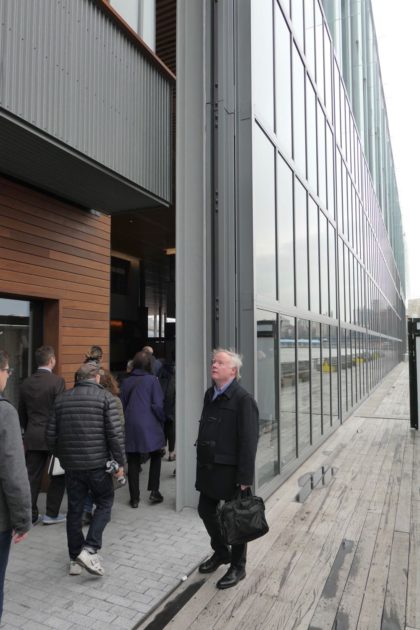
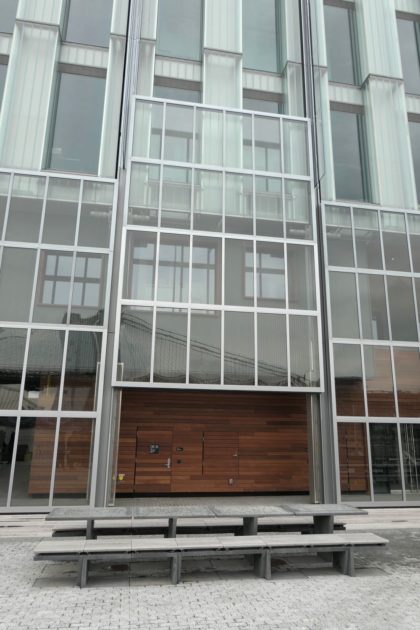 The ground floor is a two-story high space, with six “buildings.” At least two of the restaurants are here—Andrew Carmellini’s and Momofuku Bar & Grill, as our host referred to it. (No clue if that’s its actual name.) The restaurants are two stories, with indoor terraces on the second level (which you can see best in the third photo).
The ground floor is a two-story high space, with six “buildings.” At least two of the restaurants are here—Andrew Carmellini’s and Momofuku Bar & Grill, as our host referred to it. (No clue if that’s its actual name.) The restaurants are two stories, with indoor terraces on the second level (which you can see best in the third photo).
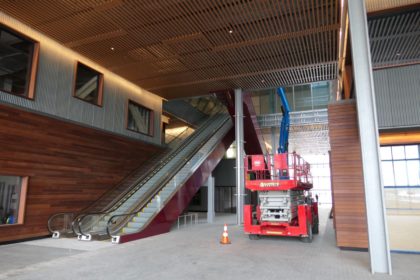
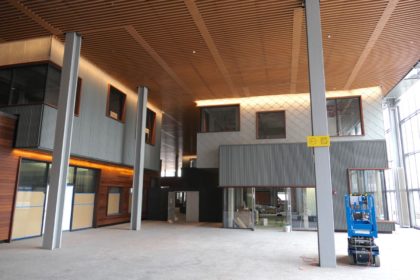
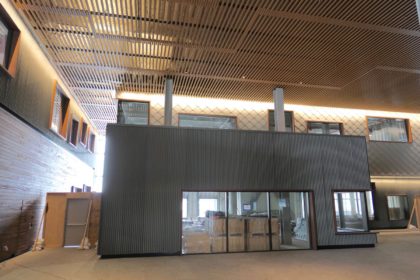 Here’s a better look at some of the materials. SHoP Architects used various tactics to add layers and enliven what is essentially a cavern: boxes stacked off-center, irregular windows, and wooden slats, corrugated metal, and faux shingles.
Here’s a better look at some of the materials. SHoP Architects used various tactics to add layers and enliven what is essentially a cavern: boxes stacked off-center, irregular windows, and wooden slats, corrugated metal, and faux shingles.
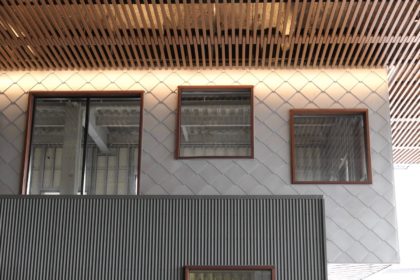 We walked through the village to the east side of the pier. The photo below is looking back toward the west. I don’t know whether HHC plans to fill these “plazas” (my word) with the kind of temporary shopping opportunities you see in other malls. I’d be surprised if it was just left open and unmonetized….
We walked through the village to the east side of the pier. The photo below is looking back toward the west. I don’t know whether HHC plans to fill these “plazas” (my word) with the kind of temporary shopping opportunities you see in other malls. I’d be surprised if it was just left open and unmonetized….
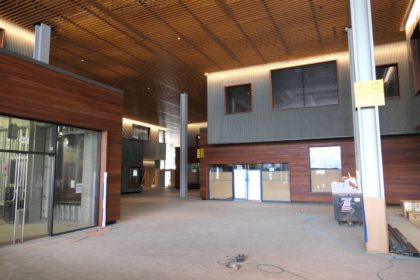 The most dramatic moment—even more than the roof, in my opinion—is the promenade on the pier’s east side. (As a general rule of thumb, any wood flooring is public space.) I assume the notch is to get visitors to engage more with the retail, so they don’t just walk around the mall mesmerized by the views.
The most dramatic moment—even more than the roof, in my opinion—is the promenade on the pier’s east side. (As a general rule of thumb, any wood flooring is public space.) I assume the notch is to get visitors to engage more with the retail, so they don’t just walk around the mall mesmerized by the views.
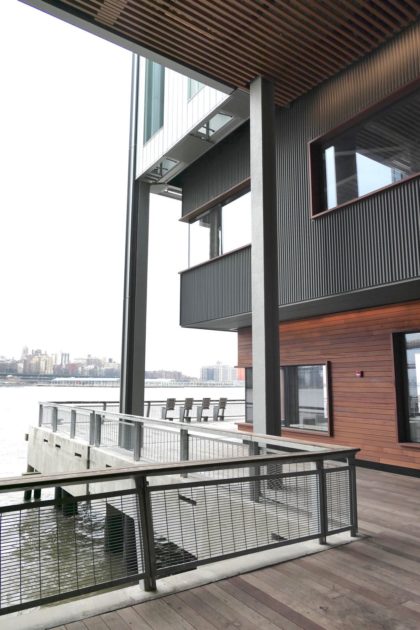
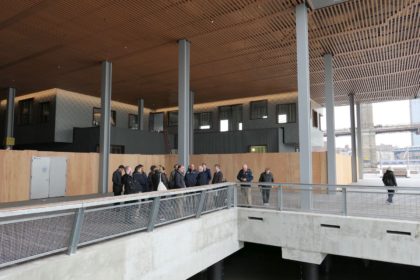
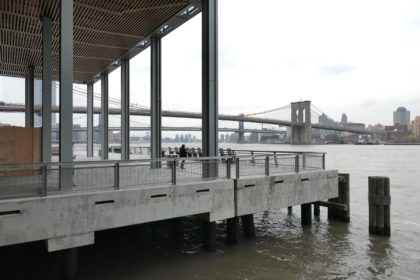
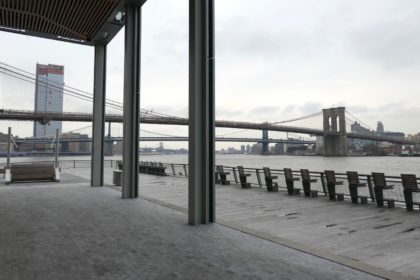 We headed over to the north “porch,” which has chairs here and there.
We headed over to the north “porch,” which has chairs here and there.

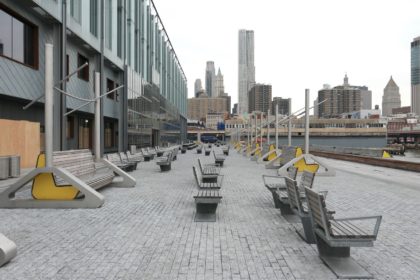 And, wow, you can really see how the One Manhattan Square condominium utterly destroys the view of the Brooklyn Bridge (as it does with the Manhattan Bridge from other angles). Everyone who let this happen should be ashamed.
And, wow, you can really see how the One Manhattan Square condominium utterly destroys the view of the Brooklyn Bridge (as it does with the Manhattan Bridge from other angles). Everyone who let this happen should be ashamed.
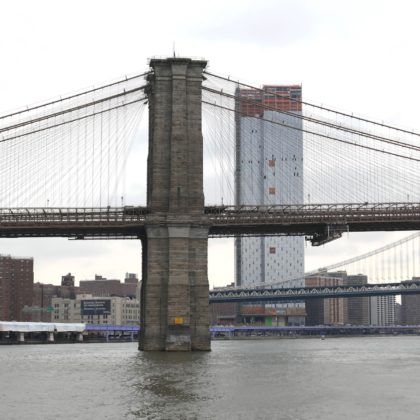 We re-entered the village on the north side.
We re-entered the village on the north side.
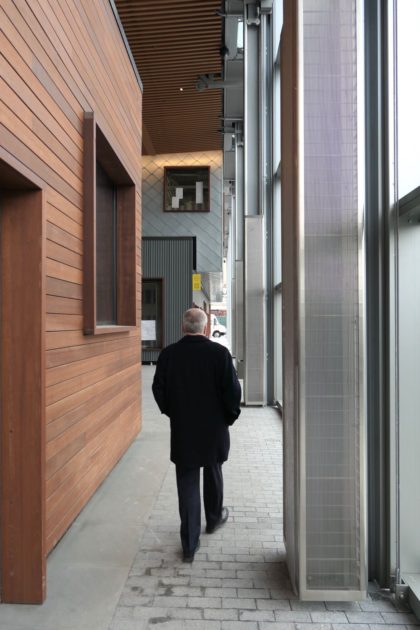
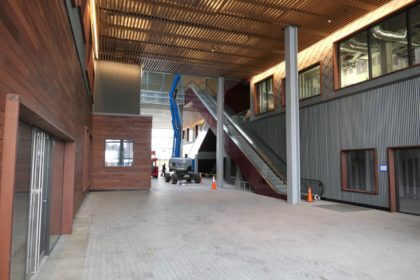 Then we rode escalators up to the third floor, where ESPN has studios. Someone from the channel spoke about ways it will broadcast from the pier. There are public restrooms on this floor, and I’m not positive, but I think they’re the only ones in the complex. (And in the Seaport District at all?) As nice as they are—and the women’s room apparently has a window—it reminded me of how anyone who wants to use a restroom at the Westfield World Trade Center mall has to pass a certain amount of retail first. We also saw raw office space. HHC would like to get something “experiential” here, rather than a law or accounting firm.
Then we rode escalators up to the third floor, where ESPN has studios. Someone from the channel spoke about ways it will broadcast from the pier. There are public restrooms on this floor, and I’m not positive, but I think they’re the only ones in the complex. (And in the Seaport District at all?) As nice as they are—and the women’s room apparently has a window—it reminded me of how anyone who wants to use a restroom at the Westfield World Trade Center mall has to pass a certain amount of retail first. We also saw raw office space. HHC would like to get something “experiential” here, rather than a law or accounting firm.
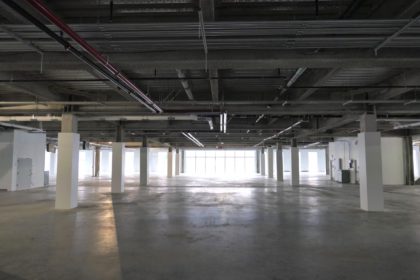 Finally, the roof. It’s hard to capture the sheer expanse of the space—or imagine what it’ll feel like when 4,000 people are at a concert there. (The stage will be on the north side, facing south.) I believe the HHC rep said that there would be food trucks on the roof, and that David Rockwell is working on a design for an ice rink in winter. We all agreed that it would be mighty chilly up there….
Finally, the roof. It’s hard to capture the sheer expanse of the space—or imagine what it’ll feel like when 4,000 people are at a concert there. (The stage will be on the north side, facing south.) I believe the HHC rep said that there would be food trucks on the roof, and that David Rockwell is working on a design for an ice rink in winter. We all agreed that it would be mighty chilly up there….
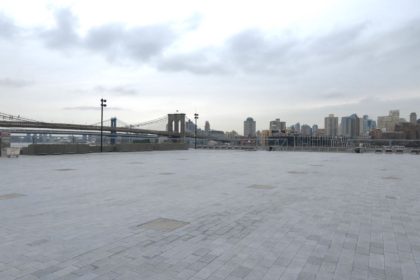 Also, you can see both the Empire State Building and the Statue of Liberty. (Trust me, it’s there.)
Also, you can see both the Empire State Building and the Statue of Liberty. (Trust me, it’s there.)
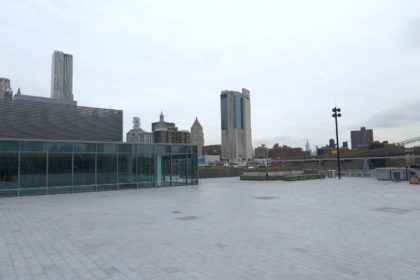
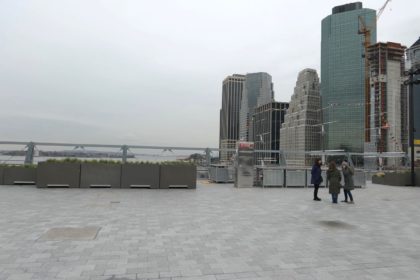 The rooftop pavilion will house a restaurant that seats around 50. I think the rep said that HHC will operate the restaurant, and that it’s first-come, first-served.
The rooftop pavilion will house a restaurant that seats around 50. I think the rep said that HHC will operate the restaurant, and that it’s first-come, first-served.
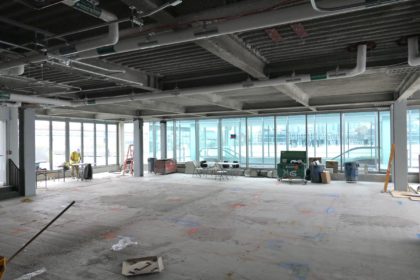 We took elevators back down to the ground floor and exited toward the west, through this dramatic passageway.
We took elevators back down to the ground floor and exited toward the west, through this dramatic passageway.
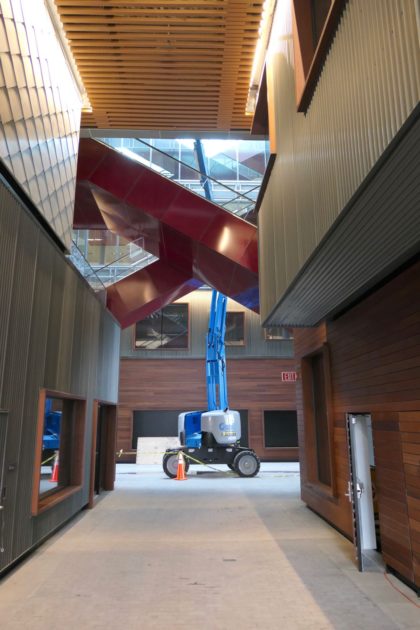 Where we were face-to-face with the demolition of the
Where we were face-to-face with the demolition of the New Market Building Tin Building. (Update: I always get those mixed up.)
7 Comments
Subscribe
Subscribe to the TC Newsletter








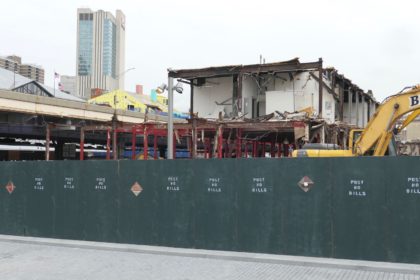
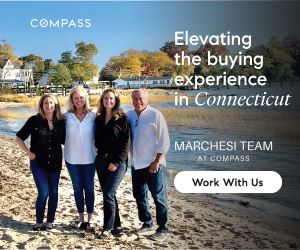






I heard the tour director say that there would NOT be any vendors set up in the open spaces of the village. They would have street furniture (seating areas) but no vendors.
There are public restrooms under the FDR, at Pier 15.
Yep, but I don’t know whether those are Parks Department restrooms or Seaport District ones.
You uncharacteristically don’t really say what you thought of it (“dramatic” can go either way). I realize it was a cloudy day but it all looks so depressing in the photos. That last “ dramatic” passageway looked like I would be afraid of something falling on my head. I realize it’ll be livelier when there’s stuff in there, but it reminds me of the Fulton Center—there was all this hype about how “light-filled” and beautiful it would be, but every time I walk in there it’s so dreary that I just want to leave. What do you think this will be like as a public space?
I haven’t thought enough about this to answer as thoughtfully as I should—and I don’t think you can underestimate the weather on the photos—but my initial feeling was that SHoP did a neat job of creating multiple interesting moments in what might’ve otherwise been a large block (which is how I remember the old Pier 17). It’s all a bit cold now, because there’s nothing there yet; then again, the WTC Oculus never looked as good as it did before the stores arrived. I will say that I’m not a fan of some of the textures and layers: It’s probably too much, and some of it will be turn dated (especially the elements that remind me of shipping containers, which must have felt fresher five years ago). Finally, while I might’ve preferred a grand public space, that’s not necessarily what HHC needs to lure people to the Seaport. (Or is it? If, say, a major museum opened there, would that help traffic more that shops, restaurants, etc.?)
They have absolutely killed one of the most iconic views in the western hemisphere.
While unfortunate, this is also ironic in a way, given the history of the Brooklyn Bridge:
From “The Great Bridge” by David McCullough
“The towers, the ‘most conspicuous features,’ would be identical and 268 feet high. They would stand on either side of the river, in the water but close to shore, their foundations out of sight beneath the riverbed. Their most distinguishing features would be twin Gothic arches — two in each tower — through which the roadways were to pass. These arches would rise more than a hundred feet, like majestic cathedral windows, or the portals of triumphal gateways. […]
“[Roebling’s] towers would dwarf everything else in view. They would reign over the landscape like St. Peters in Rome or the Capitol dome in Washington, as one newspaper said. In fact, the towers would be higher than the Capitol dome if the dome’s crowning statue of Freedom was not taken into account. So this in the year 1869 — when the Washington Monument was still an ugly stone stump — meant they would be about the largest, most massive things ever built on the entire North American continent. On the New York skyline only the slim spire of Trinity Church at the head of Wall Street reached higher.”
See also:
http://collections.mcny.org/Collection/%5BBuilding%20the%20Brooklyn%20Bridge.%5D-2F3XC5IPD9XK.html